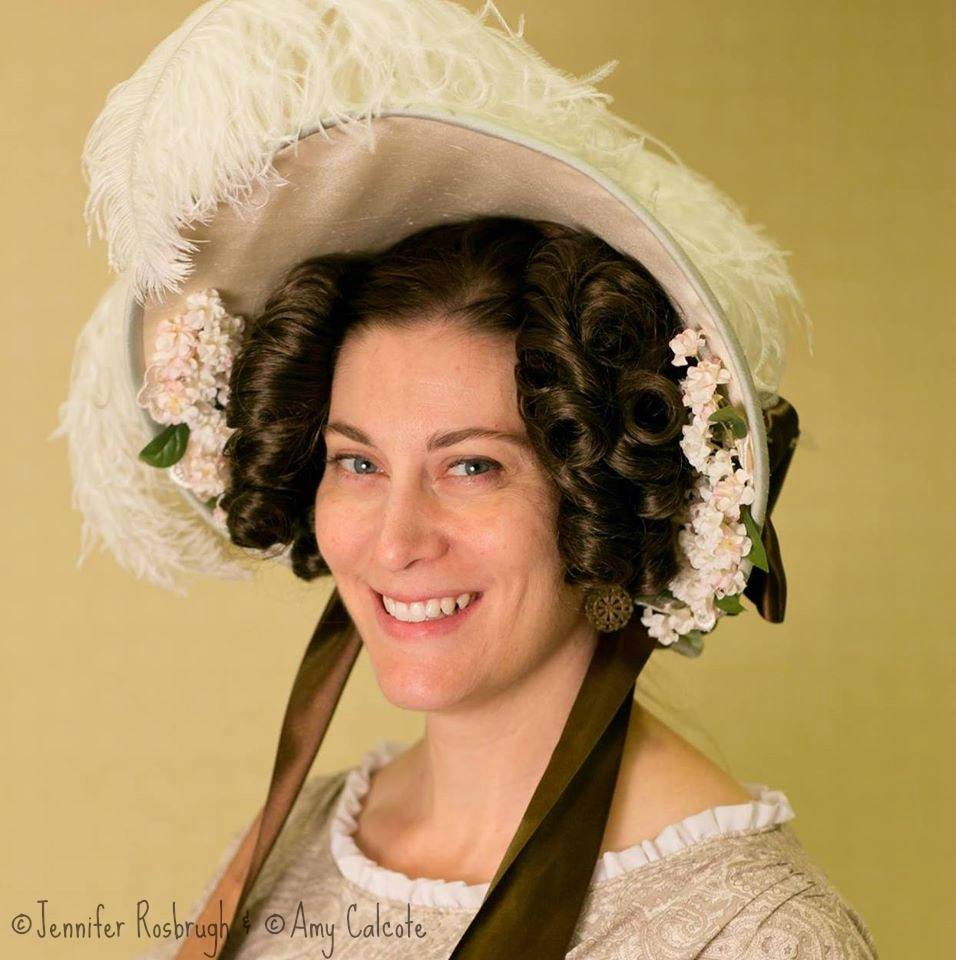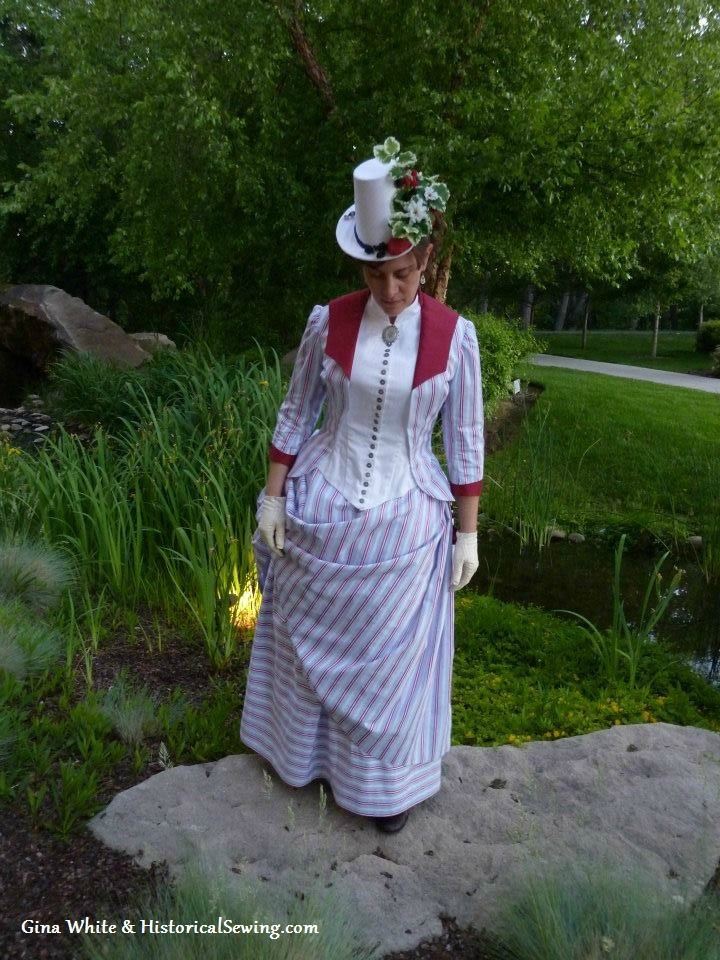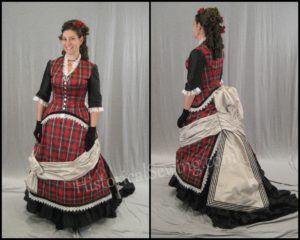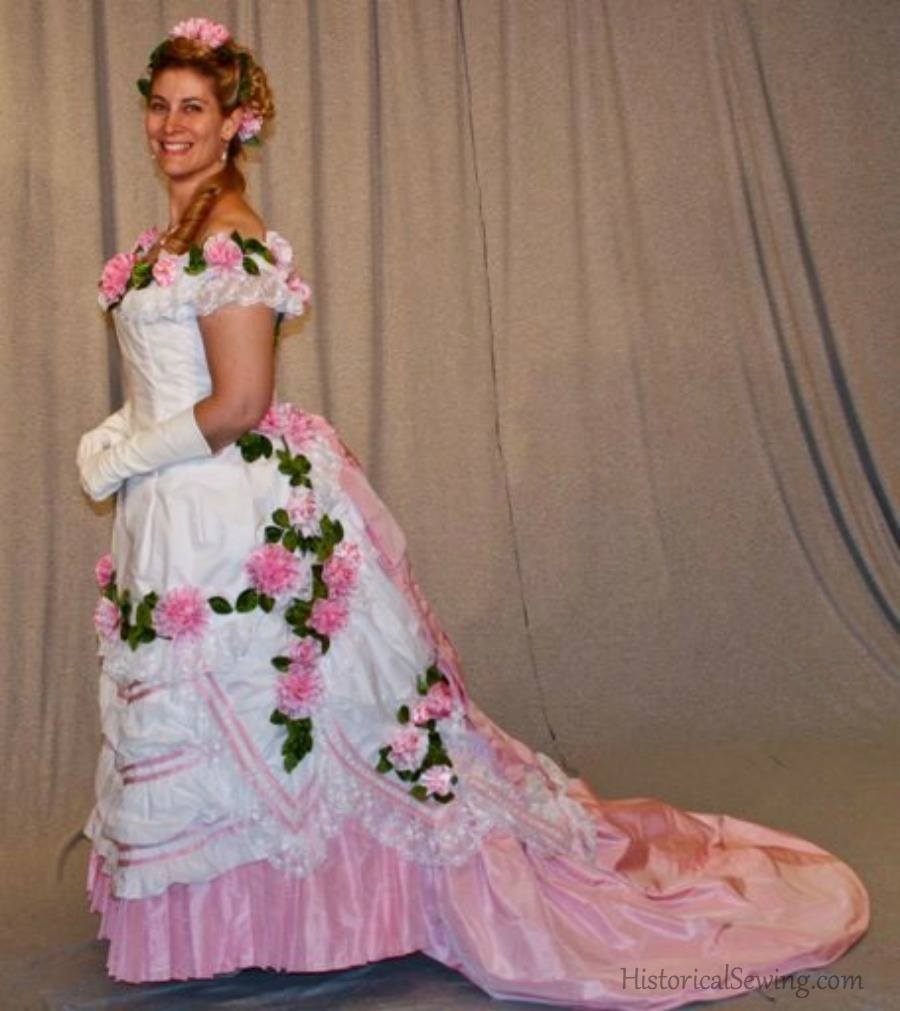Spotlight: Jennifer Rosbrugh and Old Petticoat Shop
Jennifer Rosbrugh is the Owner of Old Petticoat Shop and the blog: HistoricalSewing.com. She teaches the art of making historical costumes and clothing items, primarily 19th century but including some 18th century and early 20th. She does this through online sewing classes ranging from undergarments to hats & bonnets, as well as detailed posts on her blog. Her shop sells sewing patterns focusing on undergarments and accessories, which she considers important items when creating a historical silhouette! We reached out to Jennifer to find out more about her story and her businesses. She gave such great responses that we are including them here verbatim.
We asked Jennifer how she got started sewing, and she told us “When I graduated from high school in the early 1990s, my mom said I could choose from either a sewing machine or typewriter (ha!) as a gift. As my background has nearly always been business-oriented since selling pom-pom creatures when I was four in my grandparents’ shop to majoring in business in college, it was a super tough choice! I ended up with the sensible typewriter. But oh, how my heart longed for a machine of my own!”
Jennifer began sewing perhaps around age five with at first “ little things, you know – but by age 12 and into high school I was making most of my clothes. Favorites were dresses with Victorian touches and floral vests – Molly Ringwald/1980s/Victorian-inspired stuff. Most of the basic skills were taught to me by my grandmother. My mom sewed a little but didn’t have time to teach me as much. Back in the day I was able to take the class, Clothing, as a high school sophomore as an elective. I didn’t have a sewing machine in college (see above) so didn’t sew much for a few years. My very own machine was bought in 1997 and I began sewing wardrobe pieces again. I attended the Fashion Institute of Design and Merchandising (FIDM) a few years after college to gain skills in pattern drafting and draping. “
We asked Jennifer how she became interested in period costuming. She told us, “It’s part of those long-ago, fuzzy memories where you can’t pinpoint its origination. Anne of Green Gables with Megan Follows captured my mind with romantic sensibilities. But the obscure Disney film Summer Magic with Hayley Mills really started the passion. I fell in love with the girls’ outfits in the movie and was fascinated that they could make their own party dresses from a “most wonderful book of patterns.” The charm of Victoriana hooked me early!”
“In 1998, as I was sewing my own clothes again, I discovered Jennie Chancey’s “Titanic Dress Project” when that movie’s costumes gave fuel to the historical costuming community, and her pattern line, Sense and Sensibility for Regency-inspired clothing. Then I stumbled upon the Truly Victorian pattern line. I was genuinely shocked that there were sewing patterns I could buy to make the lovely Victorian dresses I dreamed about. Being so dependent on patterns to make clothes, this discovery made my heart swell with anticipation and creativity. As I went through the program at FIDM I focused many class projects on period costumes – specifically 19th century based.”
We then asked Jennifer what advice she would give to someone starting out in period costuming. She replied: “Find that time period that calls to you – that speaks straight to your heart – and focus there to build your skills of fabric selections, proper silhouette with undergarments and structures, construction techniques, and finishing touches including accessories. Starting with an era you love will motivate you to keep going and learning. Then, branch out to other eras.”
“Remember to always follow your heart. Life is too short to make concessions because someone else doesn’t like the direction you are going in. However, if you are costuming under the direction of a superior, like for a theater production, then go by their guidelines until you can call the shots.”
“Period costuming is creative and personal; those of us in it tend to focus on a few specific elements – being historically accurate, fine hand sewing, brilliant tailoring, perfecting the paper pattern, selecting the best fabrics and colors, etc. There’s no “right or wrong,” simply good and bad choices. Go forth with confidence that each project is for learning about the art and discovering yourself.”
We really love these bullet points!
- Don’t give unsolicited advice.
- Teach someone else a skill you’ve developed.
- Keep eyes open for options and possibilities to explore.
- Take breaks.
- Remember it won’t ever be perfect; but strive for excellence.
- Do the quick and dirty project once in a while as well as the challenge garment that takes dozens of hours to keep your mind and skills fresh.
- Putting projects in time-out is okay.
- Encourage others coming behind you.
- Celebrate the victories both big and small.
- Keep moving forward!
We asked what sets Jennifer’s company apart, and she said, “My blog and shop go well beyond the modern-sewing hobby that seems to be mostly home dec and knit clothing items. As “cosplay” and historical fashion interest has grown into mainstream sewing, my niche is to provide accessible resources on how to use historically accurate techniques and materials in customers’ creations but also show short-cuts, too, for the busy 21st century dressmaker. Those who love 19th century fashion, whether they work on limited time frames and budgets or have full resources, are welcome in our Joyful community. I take costumers at all levels on a journey building their skills then watch them fly. I encourage my fans and customers to follow their hearts when sewing – whether that be time-period accurate or a historical mash-up. My goal is that my followers will share their (historical) creativity with the world in the ways that suit them.”
When we asked Jennifer to tell us about a couple of her proudest projects or moments she said, “Every comment, email and post I receive from students showing off their success in a challenging (for them) project my heart rejoices. I’m proud of them for pushing through, past their personal barriers and preconceived notions, into accomplishing a goal. These successes for them encourage me to push forward in my own goals of continuing to teach historical garment sewing.”
“As for a specific project I’m proud of it would be my 1875 Scotch & Soda evening dress. It is a dear dress to me as I made it from silk tartan in my ancestor’s sett pattern, MacGregor. The fabric was ordered from Scotland, and I reproduced an elegant fashion plate. The challenge of reproducing the plate is a wonderful memory and goal met. But I think I’m most proud of cutting and matching that red plaid fabric – the most expensive I’ve ever purchased! To me it has meaning beyond a mere Victorian bustle dress.”
“And for a truly selfish and proud moment, that was at a Jane Austen festival. My husband and I were fully dressed out in Regency attire that I had made (excluding hats and shoes) and accompanied by a friend who is a marvelous costumer. The main event was in a community hall and we arrived about a half-hour after the start. People were milling about among the few dozen vendor booths. Not knowing anyone, when the three of us walked through the doorway the entire room “stopped” and all eyes turned to us. We felt like the party arriving from Netherfield! (Pride & Prejudice reference.) We were quite honored and proud for affecting the entire event that way knowing we looked as if we stepped out of time.”
Finally, we asked Jennifer what has been the most challenging project and/or hurdle that she has had to overcome. She replied, “Great question! Since I’ve been sewing for near 35 years there have been several projects that have challenged my talents and improved my skills. Every top and skirt and costume is a learning experience, but not every one has stretched me.”
“My most challenging project would probably be my 1876 evening dress – the “Wedding Cake Dress.” The design was from a fashion plate from Godey’s Lady’s Book – a prominent 19th C. publication similar to modern Vogue. It was the first project I wanted to reproduce as exactly as could be. I wanted to look like that fashion plate!”
“That gown taught me so much about Victorian fashion and construction – its layers, fabrics, trims, and the impossible-to-achieve fashion plate proportions. It challenged my fitting skills and pattern drafting abilities to date, going well beyond the basics I had learned at fashion school. That dress taught me loads about scale when reproducing a design from a sketch or painting or photograph. I acquired a deeper understanding of fabric selections based on period descriptions and translating that into available modern materials. The underlining layers and under-structure tested my knowledge and opened up new techniques to producing the desired silhouette. I love the gown and would, of course, change a couple things if I ever re-did it simply due to what I learned about the process immediately afterwards and in the last few years too.”
You can find out more about Jennifer, her classes and talent, at:
Blog: http://historicalsewing.com/
Online Classes: http://classes.historicalsewing.com/
Shop: https://oldpetticoatshop.com/
You can find her everyday on Facebook: https://www.facebook.com/HistoricalSewing
Instagram: https://www.instagram.com/historicalsewing/
Email: Sewing@HistoricalSewing.com






